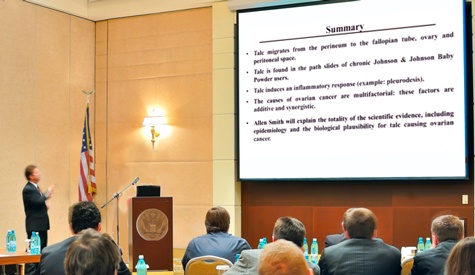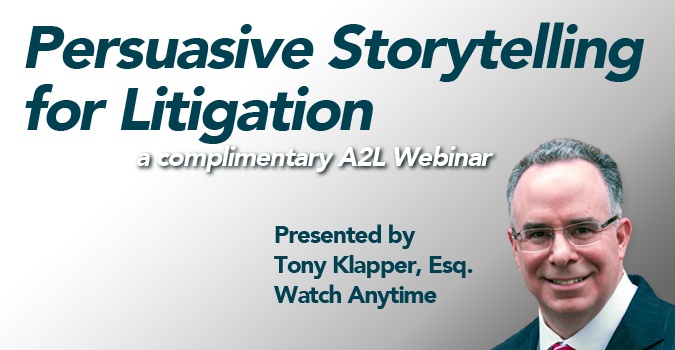by Ken Lopez
Founder/CEO
A2L Consulting
We recently asked three top trial lawyers about what makes them so successful in the courtroom. They are quite a successful trio. One of them is Bobby Burchfield of King & Spalding, whose bio notes, “Mr. Burchfield has never lost a jury trial.” That's an especially impressive track record as he's been in practice more than 30 years.
So what does winning take? Well, as we saw in previous clips from the same interviews, these trial lawyers believe, as we do, that storytelling is at the heart of building a successful case. Furthermore, as all demonstrative evidence consultants and most trial lawyers will tell you, combining persuasive visual evidence with persuasive oral communications produces a truly synergistic persuasive effect. Persuasion is a rare circumstance where 1+1 really does equal more than 2.
Of course, as we have long counseled, just because something is projected on a screen does not make it helpful at a trial. In many cases, as in the case of lawyers who use bullet points to summarize their arguments on screen, some visuals actually make you less persuasive. If yours looks like the image here, then you are certainly doing more damage than good.
For more on why that's true, please see our articles 12 Reasons Bullet Points Are Bad (in Trial Graphics or Anywhere), The 12 Worst PowerPoint Mistakes Litigators Make, and Why Reading Your Litigation PowerPoint Slides Hurts Jurors.
In this three-minute clip, we hear from the best of the best -- Bobby Burchfield of King & Spalding, Rob Cary of Williams & Connolly, and Patrick Coyne of Finnegan. And we certainly don't hear them talking about the power of bullet pointed lists.
Instead, you hear these trial-tested litigation experts talking about the use of animation, the value of timelines, and the importance of showing real evidence to ground your argument in credibility.
Burchfield said, “People learn both by seeing and by hearing, and if you can combine those two in one presentation, the more sensory perceptions you combine, the better off you are. Timelines are powerful persuasive tools. A timeline shows from left to right who did what and to whom. Sometimes you show in a timeline above the line what your client knew and below the line what your client didn’t know. It can be a powerful story to show contrasting events that were going on simultaneously. This helps the jury put the entire case into context.”
Cary noted, “When a jury can see something that visually displays the evidence, that cloaks you in credibility. That’s critical in earning their trust.”
Coyne pointed out, “People are predominantly visual. Most people need an image. They need it to tie things together. Ken [Lopez] and his people did a fantastic animation for us. The judge turned to the other side and said, ‘If I credit this animation, you lose. Do you know that?’ It was a very compelling animation. That’s what I mean by appealing to the judge by giving him a visual that explains what you’re trying to say.”
Watching lawyers like these work is a pleasure and their teams score high on our assessment of what makes a great trial team.
Other articles related to persuasion in trial, the use of bullet points, and trial presentation best practices from A2L Consulting:
- Don't Use PowerPoint as a Crutch in Trial or Anywhere
- 6 Trial Presentation Errors Lawyers Can Easily Avoid
- 12 Reasons Bullet Points Are Bad (in Trial Graphics or Anywhere)
- 10 Criteria that Define Great Trial Teams
- How Much Text on a PowerPoint Slide is Too Much?
- 5 Ways to Maximize Persuasion During Opening Statements - Part 4
- Free A2L Consulting Webinar: Persuasive Storytelling for Litigation
- The 12 Worst PowerPoint Mistakes Litigators Make
- 12 Ways to SUCCESSFULLY Combine Oral and Visual Presentations
- The Effective Use of PowerPoint Presentation During Opening Statement
- 16 PowerPoint Litigation Graphics You Won't Believe Are PowerPoint






Leave a Comment